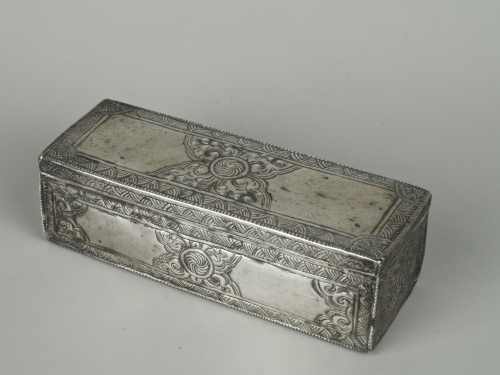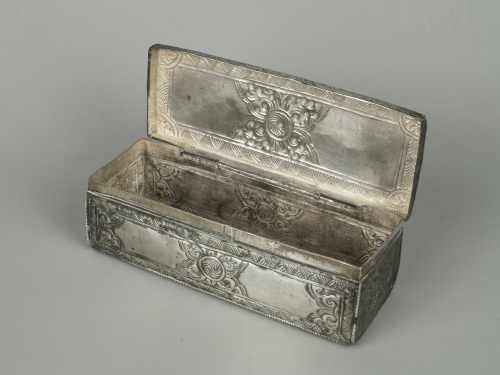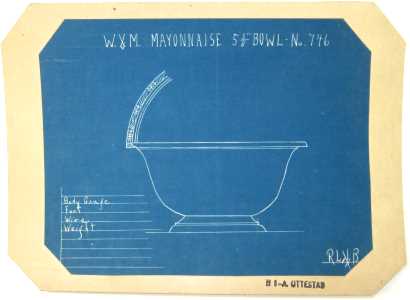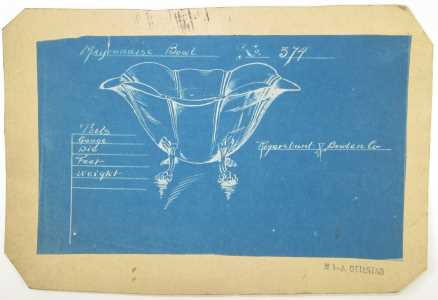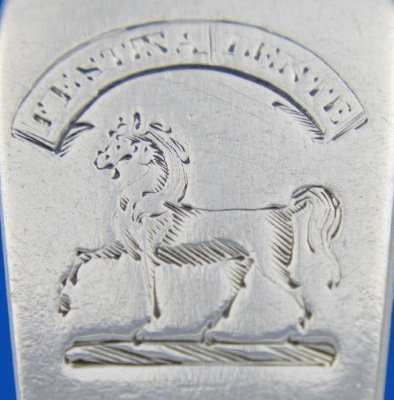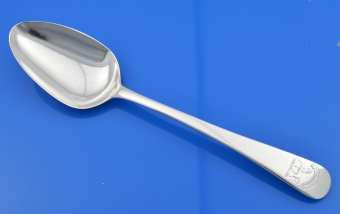
|
|||||
YOUR GUIDE TO JULY NEWSLETTER:
new members
members' window
mail to ASCAS
replies to questions
a page per month
a silversmith per month
a word per month |

MARKS OF EUROPEAN SILVER PLATE: XIV. WÜRTTEMBERGISCHE METALLWARENFABRIK (WMF) Marks of Hollow Ware and Trays The latest investigation of Dr. David N. Nikogosyan is a tremendous step forward in the understanding of marks on the silver-plated items produced by Wurtemberg Metalware Factory (WMF). Together with more precise dating of the already known stamps of this company, the author managed to identify a whole new class of marks used for export products made especially for the UK/USA and Austria-Hungary markets. This breakthrough was simultaneously achieved for both hollow ware and cutlery. In addition, the author discovered so-called "small marks" on hollow ware which were used when there was not enough space for customary marking. Concerning cutlery products, Dr. D.N. Nikogosyan described for the first time the marks on napkin rings, and identified the Art Deco ostrich mark, used for the items of higher artistic quality. The total number of mark photos has been increased from 94 to 169 for hollow ware products and from 103 to 150 for cutlery and napkin rings. The revised WMF Cutlery page will be presented in August 2017 Newsletter click here |
Mail to ASCAS: e-mail
silverassociation@yahoo.itAdam Goldsmith writes:
...Maybe one of your many readers could solve a mystery for me.
I recently bought this spoon made in Moscow between 1899 and 1908 by Fedor Loprie. It is about 14cm long. My mystery is why would it have the strange top to it which seems to have been made like this and not added on at a later stage.
Any suggestions would be very welcome.
Thanks
Adam Goldsmith
Replies to questions
Nelly Wolfenden receives these answers about her mysterious item (see June 2017 Newsletter)
Norma L. Young writes
Looks like suspension hook (ie over a lady's belt) which would be
used for Chatelaine type attachments... although 1907
is too late for using those... (except maybe housekeepers in a big grand country
mansion) might it be even a bookmark?
Norma L. Young
Alan Yates writes
in my opinion the item owned by Nelly Wolfenden is a chatelaine. The plain leg is slipped under a belt and keys were hung from the chains. Typically used by a nurse or a housekeeper
Alan Yates
"A PAGE per MONTH"
In this column we presents a page obtained from makers'
brochures, books, auction catalogs, advertising or whatever
other printed paper, related to silver, that may be of interest
for ASCAS members.
The images will be published at a "low resolution" level and for
private and personal use only.
This column is published under the kind permission of Giorgio
Busetto's website

This month ASCAS presents an 1891 advertisement of
J.H. JOHNSTON & CO
17 UNION SQUARE
NEW YORK
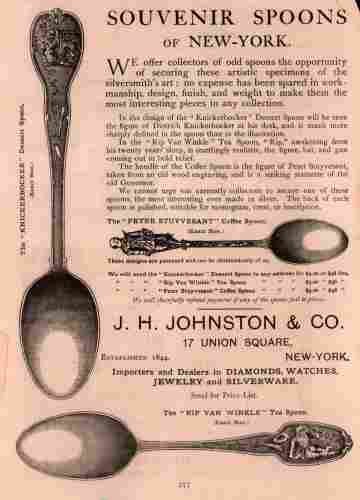
Business started by JH Johnston c.1860 succeeding to Many & Levis.
The firm became JH Johnston & Co in 1882 and JH Johnston & Son in 1899. Out of business in the 1910s.
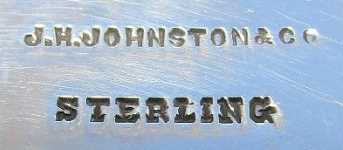

"A WORD per MONTH"
In this column we present an abstract from a page of the "What is? Silver Dictionary"
courtesy of


BETEL BOX
The betel (Piper betle) is the leaf of a vine belonging to the Piperaceae family, which includes pepper and kava.
Chewing the mixture of betel leaf and areca nut is a tradition, custom or ritual from South Asia to the Pacific. It constitutes an important and popular cultural activity in many Asian and Oceanic countries.
It is not known how and when the areca nut and the betel leaf were combined together into one psychoactive drug. Archaeological evidence from Thailand, Indonesia and the Philippines suggests that they have been used since antiquity.
Slices of the areca nut would be wrapped in betel leaves and chewed, giving a mild stimulant effect. Sometimes tobacco and slaked lime would be included in the betel nut mixture as this releases the alkaloid of the nut.... MORE...
"A SILVERSMITH per MONTH"
In this column
we present marks, information and history of silversmiths and
silver manufacturers.
This column is published under the kind permission of Giorgio
Busetto's website

LUNT SILVERSMITHS
ROGERS, LUNT & BOWLEN COMPANY
Lunt Silversmiths began its activity and was incorporated in Greenfield, MA in 1902 as Rogers, Lunt & Bowlen Company.
The firm succeeded to A. F. Towle & Son Co purchasing its tools, machinery, trademarks and good-will.
The business was managed by George E. Rogers (1849-1915, President and major investor), George Colby Lunt (Treasurer and General Manager) and William Caldwell Bowlen (1868-1934, Vice President and supervisor of manufacturing until his retirement in 1929).
George C. Lunt and William C. Bowlen were both qualified members of the staff of the defunct Towle's factory.
The company would become a celebrated domestic designer and producer of flatware, hollowware, and giftware for generations to come remaining in Lunt family hands for more than 100 years, making it the oldest continuously operating family-owned silver company in the United States.....
MORE...
"A CREST per MONTH"
In this column we
present images and descriptions of Crests and Mottoes of British,
Irish and Scottish families as engraved on silver items.
This column is published under the kind permission of Giorgio
Busetto's website

FAMILY CRESTS: LIST OF NAMES
ILLUSTRATED DIRECTORY OF FAMILY CRESTS
TROTTER
The crest of Trotter family (Glenkens, Galloway).
The Latin motto is 'Festina lente' (Diligently, but not hurriedly)
The crest is described as 'horse trotting'
The crest was found on a silver spoon hallmarked London 1806, maker William Eley & William Fearn
"A YEAR per MONTH"
FROM SHEFFIELD ASSAY OFFICE REGISTER
- 1778 -
This table is obtained from The Book of Entries of the Names, Places of abode and Marks of the several Silversmiths and Plate Workers residing in Sheffield, or within twenty miles thereof, who are required to send their goods to the Assay Office, lately established in the Town of Sheffield by an Act of Parliament lately passed in the Thirteenth Year of the Reign of King George the Third intituled:
An Act for appointing Wardens and Assaymasters for
Assaying Wrought Plate in the Towns of Sheffield
and Birmingham
YEAR 1778



Closing our July 2017 edition of ASCAS Newsletter I hope
you have appreciated its content.
Your comments, suggestions and advice will be of great help.
My thanks to Wayne Bednersh, Adam Goldsmith, David N. Nikogosyan, Alan Yates and Norma L. Young for their precious contributions.
Giorgio Busetto
Secretary
DISCLAIMER AND PRIVACY POLICY
ASCAS is a community of people having a common
interest in antique silver.
It is a non-profit association without commercial links.
Membership is open to whomever has a true interest in
this subject matter.
ASCAS has no real property and no fees are requested nor
accepted from members.
ASCAS keeps in touch with its members only through
periodical newsletters, e-mails and web-site updating
and ignores and is not responsible for any other
activity pursued by its members.
Likewise, ASCAS is not responsible for opinions,
evaluation and images displayed, and in any form
published or supplied for publication, by its members
who, in any case, maintain the property of their works
and assure the respect of national and international
legislation about Intellectual Property.
ASCAS does not have the full addresses of its members (only
town, country and e-mail address are requested for
membership).
ASCAS handles and protects with care its members' e-mail
addresses, will not disclose the addresses to third
parties, will use this information only to reply to
requests received from members and for communications
strictly related to its activity.
These rules are expressly accepted by submitting the
membership request.
The firm became JH Johnston & Co in 1882 and JH Johnston & Son in 1899. Out of business in the 1910s.


"A WORD per MONTH"
In this column we present an abstract from a page of the "What is? Silver Dictionary"courtesy of
BETEL BOX
The betel (Piper betle) is the leaf of a vine belonging to the Piperaceae family, which includes pepper and kava.
Chewing the mixture of betel leaf and areca nut is a tradition, custom or ritual from South Asia to the Pacific. It constitutes an important and popular cultural activity in many Asian and Oceanic countries.
It is not known how and when the areca nut and the betel leaf were combined together into one psychoactive drug. Archaeological evidence from Thailand, Indonesia and the Philippines suggests that they have been used since antiquity.
Slices of the areca nut would be wrapped in betel leaves and chewed, giving a mild stimulant effect. Sometimes tobacco and slaked lime would be included in the betel nut mixture as this releases the alkaloid of the nut.... MORE...
"A SILVERSMITH per MONTH"
In this column
we present marks, information and history of silversmiths and
silver manufacturers.
This column is published under the kind permission of Giorgio
Busetto's website

LUNT SILVERSMITHS
ROGERS, LUNT & BOWLEN COMPANY
Lunt Silversmiths began its activity and was incorporated in Greenfield, MA in 1902 as Rogers, Lunt & Bowlen Company.
The firm succeeded to A. F. Towle & Son Co purchasing its tools, machinery, trademarks and good-will.
The business was managed by George E. Rogers (1849-1915, President and major investor), George Colby Lunt (Treasurer and General Manager) and William Caldwell Bowlen (1868-1934, Vice President and supervisor of manufacturing until his retirement in 1929).
George C. Lunt and William C. Bowlen were both qualified members of the staff of the defunct Towle's factory.
The company would become a celebrated domestic designer and producer of flatware, hollowware, and giftware for generations to come remaining in Lunt family hands for more than 100 years, making it the oldest continuously operating family-owned silver company in the United States.....
MORE...
"A CREST per MONTH"
In this column we
present images and descriptions of Crests and Mottoes of British,
Irish and Scottish families as engraved on silver items.
This column is published under the kind permission of Giorgio
Busetto's website

FAMILY CRESTS: LIST OF NAMES
ILLUSTRATED DIRECTORY OF FAMILY CRESTS
TROTTER
The crest of Trotter family (Glenkens, Galloway).
The Latin motto is 'Festina lente' (Diligently, but not hurriedly)
The crest is described as 'horse trotting'
The crest was found on a silver spoon hallmarked London 1806, maker William Eley & William Fearn
"A YEAR per MONTH"
FROM SHEFFIELD ASSAY OFFICE REGISTER
- 1778 -
This table is obtained from The Book of Entries of the Names, Places of abode and Marks of the several Silversmiths and Plate Workers residing in Sheffield, or within twenty miles thereof, who are required to send their goods to the Assay Office, lately established in the Town of Sheffield by an Act of Parliament lately passed in the Thirteenth Year of the Reign of King George the Third intituled:
An Act for appointing Wardens and Assaymasters for
Assaying Wrought Plate in the Towns of Sheffield
and Birmingham
YEAR 1778



Closing our July 2017 edition of ASCAS Newsletter I hope
you have appreciated its content.
Your comments, suggestions and advice will be of great help.
My thanks to Wayne Bednersh, Adam Goldsmith, David N. Nikogosyan, Alan Yates and Norma L. Young for their precious contributions.
Giorgio Busetto
Secretary
DISCLAIMER AND PRIVACY POLICY
ASCAS is a community of people having a common
interest in antique silver.
It is a non-profit association without commercial links.
Membership is open to whomever has a true interest in
this subject matter.
ASCAS has no real property and no fees are requested nor
accepted from members.
ASCAS keeps in touch with its members only through
periodical newsletters, e-mails and web-site updating
and ignores and is not responsible for any other
activity pursued by its members.
Likewise, ASCAS is not responsible for opinions,
evaluation and images displayed, and in any form
published or supplied for publication, by its members
who, in any case, maintain the property of their works
and assure the respect of national and international
legislation about Intellectual Property.
ASCAS does not have the full addresses of its members (only
town, country and e-mail address are requested for
membership).
ASCAS handles and protects with care its members' e-mail
addresses, will not disclose the addresses to third
parties, will use this information only to reply to
requests received from members and for communications
strictly related to its activity.
These rules are expressly accepted by submitting the
membership request.
Chewing the mixture of betel leaf and areca nut is a tradition, custom or ritual from South Asia to the Pacific. It constitutes an important and popular cultural activity in many Asian and Oceanic countries.
It is not known how and when the areca nut and the betel leaf were combined together into one psychoactive drug. Archaeological evidence from Thailand, Indonesia and the Philippines suggests that they have been used since antiquity.
Slices of the areca nut would be wrapped in betel leaves and chewed, giving a mild stimulant effect. Sometimes tobacco and slaked lime would be included in the betel nut mixture as this releases the alkaloid of the nut.... MORE...
"A SILVERSMITH per MONTH"
In this column
we present marks, information and history of silversmiths and
silver manufacturers.
This column is published under the kind permission of Giorgio
Busetto's website

LUNT SILVERSMITHS
ROGERS, LUNT & BOWLEN COMPANY
Lunt Silversmiths began its activity and was incorporated in Greenfield, MA in 1902 as Rogers, Lunt & Bowlen Company.
The firm succeeded to A. F. Towle & Son Co purchasing its tools, machinery, trademarks and good-will.
The business was managed by George E. Rogers (1849-1915, President and major investor), George Colby Lunt (Treasurer and General Manager) and William Caldwell Bowlen (1868-1934, Vice President and supervisor of manufacturing until his retirement in 1929).
George C. Lunt and William C. Bowlen were both qualified members of the staff of the defunct Towle's factory.
The company would become a celebrated domestic designer and producer of flatware, hollowware, and giftware for generations to come remaining in Lunt family hands for more than 100 years, making it the oldest continuously operating family-owned silver company in the United States.....
MORE...
"A CREST per MONTH"
In this column we
present images and descriptions of Crests and Mottoes of British,
Irish and Scottish families as engraved on silver items.
This column is published under the kind permission of Giorgio
Busetto's website

FAMILY CRESTS: LIST OF NAMESILLUSTRATED DIRECTORY OF FAMILY CRESTS
TROTTER
The crest of Trotter family (Glenkens, Galloway).
The Latin motto is 'Festina lente' (Diligently, but not hurriedly)
The crest is described as 'horse trotting'
The crest was found on a silver spoon hallmarked London 1806, maker William Eley & William Fearn
"A YEAR per MONTH"
FROM SHEFFIELD ASSAY OFFICE REGISTER
- 1778 -
This table is obtained from The Book of Entries of the Names, Places of abode and Marks of the several Silversmiths and Plate Workers residing in Sheffield, or within twenty miles thereof, who are required to send their goods to the Assay Office, lately established in the Town of Sheffield by an Act of Parliament lately passed in the Thirteenth Year of the Reign of King George the Third intituled:
An Act for appointing Wardens and Assaymasters for
Assaying Wrought Plate in the Towns of Sheffield
and Birmingham
YEAR 1778



Closing our July 2017 edition of ASCAS Newsletter I hope
you have appreciated its content.
Your comments, suggestions and advice will be of great help.
My thanks to Wayne Bednersh, Adam Goldsmith, David N. Nikogosyan, Alan Yates and Norma L. Young for their precious contributions.
Giorgio Busetto
Secretary
Assaying Wrought Plate in the Towns of Sheffield
and Birmingham
YEAR 1778

|

|

|
Your comments, suggestions and advice will be of great help.
My thanks to Wayne Bednersh, Adam Goldsmith, David N. Nikogosyan, Alan Yates and Norma L. Young for their precious contributions.
Giorgio Busetto
Secretary
DISCLAIMER AND PRIVACY POLICYASCAS is a community of people having a common
interest in antique silver.
|








